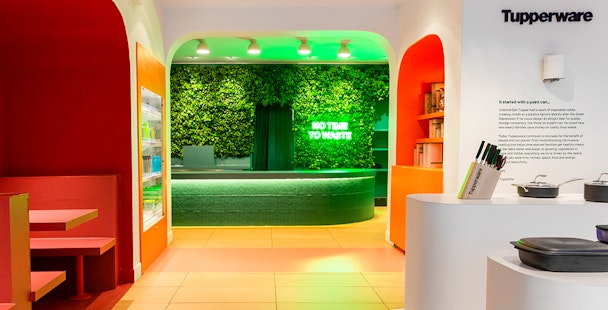After decades of direct sales, a ‘reignited’ Tupperware is finally embracing modern channels
Tupperware is racing to catch up with to the modern consumer: expanding its product line, redefining its brand for the anti-plastic generation and finally launching a shoppable website. But don’t expect an ad campaign just yet.

Tupperware's pop-up store will stay open until late December
Until October 2019, if you wanted to buy a Tupperware product you had to seek out an independent sales rep or attend a Tupperware party.
In a time of shoppable Instagram ads and cashier-less Amazon stores, the painfully archaic business model had not gone unnoticed by Tupperware Brands’ shareholders, who were lumbered with both disappointing guidance and a reduced dividends in the final quarter of 2018.
The chief executive at the time, Tricia Stitzel, promised a renewed focus on “recruiting, training, and building a productive sales force”, as well as “enhancing our use of technology and social media to help the sales force and consumers connect, while maintaining an appropriate balance of technology with face-to-face contact”.
A different story was told three months later. Stitzel promised that Tupperware was entering a “new era” in Q1 2019 and spoke not of an upskilled direct sales force but of the need for “greater engagement, access and relevance”, “updated business models” and a “streamlined” global organization. All this was to be implemented with a “sense of urgency”.
Now, just over six months on, Tupperware’s urgent makeover into a 21st century brand can be witnessed in physical form at its first-ever temporary store in New York.
Located in the pop-up Mecca of Soho, it's the brainchild of the company’s first-ever vice-president of global brand engagement, Chip Reingold, who joined permanently in July.
“Historically, the company’s communications and engagement had been about feeding into and supporting the sales force, which we still do,” he said. “I’m giving [the role] more of a consumer bent.
"Consumer time and behavior has shifted, so there's a recognition that we need other touch points – we need to bring this brand to people and put it directly into their hands.”

Reingold, who first entered the Tupperware world as a consultant last year, believes the brand itself to be almost indestructible. It reminds people of their childhoods, he said, and is synonymous with reliability and durability.
The real problem lies in access. Research carried out by the company shows “people still want Tupperware” – they just can’t be bothered to seek out a sales rep to buy it from, or they don’t know how.
The pop-up is a rudimentary solution to that. It houses more than just lunchboxes; the inclusion of microwavable grills, nifty wine bottle openers and pull-cord food processors demonstrates not only the breadth of Tupperware’s range but its place in the modern kitchen – a place that, in New York at least, requires compact and time-saving products.
The store also is designed to educate consumers in the part Tupperware plays in the war on single-use plastics (“We like to say, ‘Tupperware is the last plastic you'll buy’”) and in best use cases for its products with demos and real-life displays.
However, the pop-up should not be viewed as the brand’s official debut into DTC retail.
“I call it a hot house,” said Reingold. “We're really experimenting with this ... We wanted to test the waters on reaction to the brand, the product mix, and all of that can happen within here.”

That doesn’t mean to say retail – or at least experiential marketing – will be ruled off Tupperware’s list of new access points in the future. The company is, according to the brand chief, in the process of “actively investigating, pursuing and thinking about different ways to connect the brand with the consumer”.
What these channels will look like is currently unclear. But one that is already open for business is the company website, which is displayed on tablets in the Soho pop-up.
The site launched just under a month ago in the US and Canada and allows consumers to shop directly from Tupperware online for the first time in the brand’s 73-year history. Customers can also use the site to speak to a sales rep and download information on hosting a Tupperware party, in a nod to the company’s ongong commitment to the direct space.
The next step will be to roll e-commerce out across all markets (it operates in just under 100) while working out which additional channels work best for each country.
It’s only then that Reingold – a former Madison Ave creative – will allow himself to think about producing Tupperware’s first advertising campaign in decades.
“If I ran the most brilliant campaign around the world and people couldn't access the product – what would be the point of that?” he said. “You have to build the plumbing before the rest of the house – we need to build all the access points, and then promote awareness.
“I'm holding myself back because you only get one shot to do that, and as we're really reigniting the brand it needs to be fulfilled in many different ways. This is an enormous time of transformation for this company, and 2020 is just going to be incredible.”

